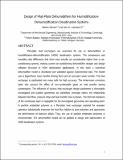Design of Flat-Plate Dehumidifiers for Humidification–Dehumidification Desalination Systems
Author(s)
Sievers, Martin; Lienhard, John H.
DownloadSieversM_LienhardJHV_DesignOfFlatPlateDehumidifiersForHumidificationDehumidificationDesalinationSystems2012.pdf (1.416Mb)
OPEN_ACCESS_POLICY
Open Access Policy
Creative Commons Attribution-Noncommercial-Share Alike
Terms of use
Metadata
Show full item recordAbstract
Flat-plate heat exchangers are examined for use as dehumidifiers in humidification–dehumidification (HDH) desalination systems. The temperature and humidity ratio differences that drive mass transfer are considerably higher than in air-conditioning systems, making current air-conditioning dehumidifier designs and design software ill-suited to HDH desalination applications. In this work a numerical dehumidifier model is developed and validated against experimental data. The model uses a logarithmic mass transfer driving force and an accurate Lewis number. The heat exchanger is subdivided into many cells for high accuracy. The Ackermann correction takes into account the effect of noncondensable gases on heat transfer during condensation. The influence of various heat exchanger design parameters is thoroughly investigated and suitable geometries are identified. Among others, the relationship between heat flow, pressure drop, and heat transfer area is shown. The thermal resistance of the condensate layer is negligible for the investigated geometries and operating point. A particle-embedded polymer as a flat-plate heat exchanger material for seawater operation substantially improves the heat flux relative to pure polymers and approaches the performance of titanium alloys. Thus, the use of particle-embedded polymers is recommended. The dehumidifier model can be applied in design and optimization of HDH desalination systems.
Date issued
2013-01Department
Massachusetts Institute of Technology. Department of Mechanical EngineeringJournal
Heat Transfer Engineering
Publisher
Taylor & Francis
Citation
Sievers, Martin, and John H. Lienhard. “Design of Flat-Plate Dehumidifiers for Humidification–Dehumidification Desalination Systems.” Heat Transfer Engineering 34, no. 7 (January 2013): 543–561.
Version: Author's final manuscript
ISSN
0145-7632
1521-0537